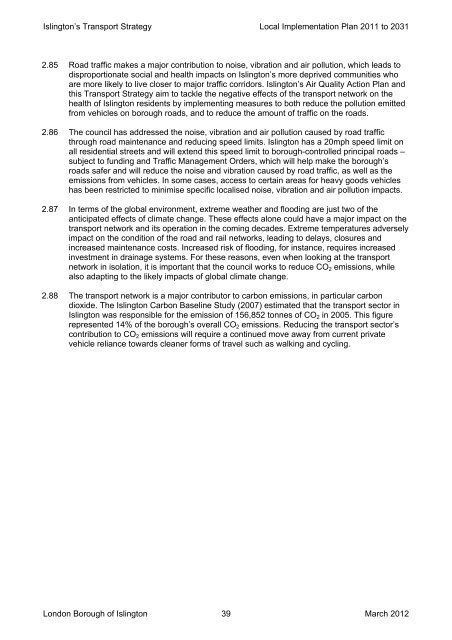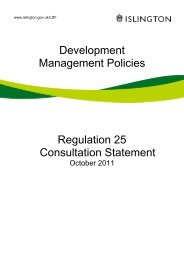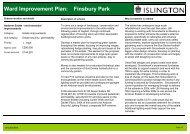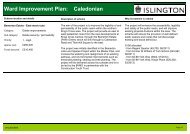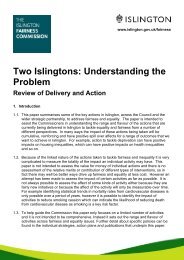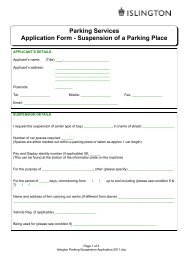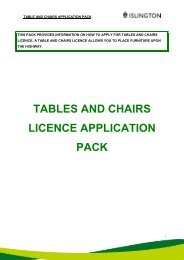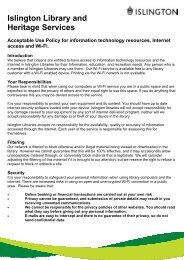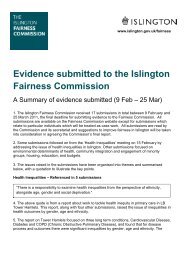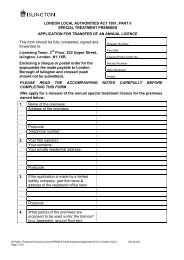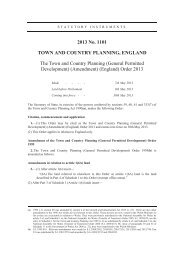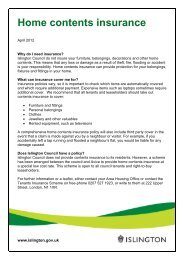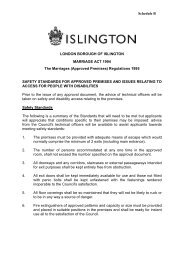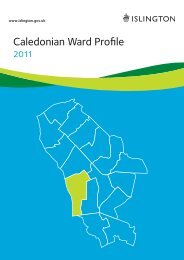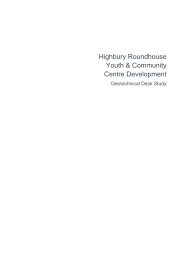Islington's Transport Strategy and Local ... - Islington Council
Islington's Transport Strategy and Local ... - Islington Council
Islington's Transport Strategy and Local ... - Islington Council
You also want an ePaper? Increase the reach of your titles
YUMPU automatically turns print PDFs into web optimized ePapers that Google loves.
<strong>Islington</strong>’s <strong>Transport</strong> <strong>Strategy</strong> <strong>Local</strong> Implementation Plan 2011 to 2031<br />
2.85 Road traffic makes a major contribution to noise, vibration <strong>and</strong> air pollution, which leads to<br />
disproportionate social <strong>and</strong> health impacts on <strong>Islington</strong>’s more deprived communities who<br />
are more likely to live closer to major traffic corridors. <strong>Islington</strong>’s Air Quality Action Plan <strong>and</strong><br />
this <strong>Transport</strong> <strong>Strategy</strong> aim to tackle the negative effects of the transport network on the<br />
health of <strong>Islington</strong> residents by implementing measures to both reduce the pollution emitted<br />
from vehicles on borough roads, <strong>and</strong> to reduce the amount of traffic on the roads.<br />
2.86 The council has addressed the noise, vibration <strong>and</strong> air pollution caused by road traffic<br />
through road maintenance <strong>and</strong> reducing speed limits. <strong>Islington</strong> has a 20mph speed limit on<br />
all residential streets <strong>and</strong> will extend this speed limit to borough-controlled principal roads –<br />
subject to funding <strong>and</strong> Traffic Management Orders, which will help make the borough’s<br />
roads safer <strong>and</strong> will reduce the noise <strong>and</strong> vibration caused by road traffic, as well as the<br />
emissions from vehicles. In some cases, access to certain areas for heavy goods vehicles<br />
has been restricted to minimise specific localised noise, vibration <strong>and</strong> air pollution impacts.<br />
2.87 In terms of the global environment, extreme weather <strong>and</strong> flooding are just two of the<br />
anticipated effects of climate change. These effects alone could have a major impact on the<br />
transport network <strong>and</strong> its operation in the coming decades. Extreme temperatures adversely<br />
impact on the condition of the road <strong>and</strong> rail networks, leading to delays, closures <strong>and</strong><br />
increased maintenance costs. Increased risk of flooding, for instance, requires increased<br />
investment in drainage systems. For these reasons, even when looking at the transport<br />
network in isolation, it is important that the council works to reduce CO 2 emissions, while<br />
also adapting to the likely impacts of global climate change.<br />
2.88 The transport network is a major contributor to carbon emissions, in particular carbon<br />
dioxide. The <strong>Islington</strong> Carbon Baseline Study (2007) estimated that the transport sector in<br />
<strong>Islington</strong> was responsible for the emission of 156,852 tonnes of CO 2 in 2005. This figure<br />
represented 14% of the borough’s overall CO 2 emissions. Reducing the transport sector’s<br />
contribution to CO 2 emissions will require a continued move away from current private<br />
vehicle reliance towards cleaner forms of travel such as walking <strong>and</strong> cycling.<br />
London Borough of <strong>Islington</strong> 39 March 2012


